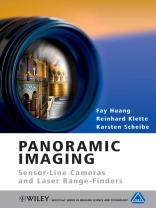Panoramic imaging is a progressive application and research area.
This technology has applications in digital photography, robotics,
film productions for panoramic screens, architecture, environmental
studies, remote sensing and GIS technology. Applications demand
different levels of accuracy for 3D documentation or
visualizations.
This book describes two modern technologies for capturing
high-accuracy panoramic images and range data, namely the use of
sensor-line cameras and laser range-finders. It provides
mathematically accurate descriptions of the geometry of these
sensing technologies and the necessary information required to
apply them to 3D scene visualization or 3D representation. The book
is divided into three parts:
* Part One contains a full introduction to panoramic cameras and
laser range-finders, including a discussion of calibration to aid
preparation of equipment ready for use.
* Part Two explains the concept of stereo panoramic imaging,
looking at epipolar geometry, spatial sampling, image quality
control and camera analysis and design.
* Part Three looks at surface modelling and rendering based on
panoramic input data, starting with the basics and taking the
reader through to more advanced techniques such as the optimization
of surface meshes and data fusion.
* There is also an accompanying website containing
high-resolution visual samples and animations, illustrating
techniques discussed in the text.
Panoramic Imaging is primarily aimed at researchers and
students in engineering or computer science involved in using
imaging technologies for 3D visualization or 3D scene
reconstruction. It is also of significant use as an advanced manual
to practising engineers in panoramic imaging. In brief, the book is
of value to all those interested in current developments in
multimedia imaging technology
قائمة المحتويات
Preface.
Series Preface.
Website and Exercises.
List of Symbols.
1. Introduction.
1.1 Panoramas
1.2 Panoramic Paintings
1.3 Panoramic or Wide-Angle Photographs
1.4 Digital Panoramas
1.5 Striving for Accuracy
1.6 Exercises
1.7 Further Reading
2. Cameras and Sensors.
2.1 Camera Models
2.2 Optics
2.3 Sensor Models
2.4 Examples and Challenges
2.5 Exercises
2.6 Further Reading
3. Spatial Alignments.
3.1 Mathematical Fundamentals
3.2 Central Projection:World into Image Plane
3.3 Classification of Panoramas
3.4 Coordinate Systems for Panoramas
3.5 General Projection Formula for Cylindrical Panorama
3.6 Rotating Cameras
3.7 Mappings between Different Image Surfaces
3.8 Laser Range-Finder
3.9 Exercises
3.10 Further Reading
4. Epipolar Geometry.
4.1 General Epipolar Curve Equation
4.2 Constrained Poses of Cameras
4.3 Exercises
4.4 Further Reading
5. Sensor Calibration.
5.1 Basics
5.2 Preprocesses for a Rotating Sensor-Line Camera
5.3 A Least-Square Error Optimization Calibration Procedure
5.4 Geometric Dependencies of R and w
5.5 Error Components in LRF Data
5.6 Exercises
5.7 Further Reading
6. Spatial Sampling.
6.1 Stereo Panoramas
6.2 Sampling Structure
6.3 Spatial Resolution
6.4 Distances between Spatial Samples
6.5 Exercises
6.6 Further Reading
7. Image Quality Control.
7.1 Two Requirements
7.2 Terminology
7.3 Parameter Optimization
7.4 Error Analysis
7.5 Exercises
7.6 Further Reading
8. Sensor Analysis and Design.
8.1 Introduction
8.2 Scene Composition Analysis
8.3 Stereoacuity Analysis
8.4 Specification of Camera Parameters
8.5 Exercises
8.6 Further Reading
9. 3D Meshing and Visualization.
9.1 3D Graphics
9.2 Surface Modeling
9.3 More Techniques for Dealing with Digital Surfaces
9.4 Exercises
9.5 Further Reading
10. Data Fusion.
10.1 Determination of Camera Image Coordinates
10.2 Texture Mapping
10.3 High Resolution Orthophotos
10.4 Fusion of Panoramic Images and Airborne Data
10.5 Exercises
10.6 Further Reading
References.
Index.
عن المؤلف
Reinhard Klette is currently a Professor and Chair in Information Technology at the University of Auckland, New Zealand. He is an experienced author, having already co-written the books Digital Geometry: Geometric Methods for Digital Picture Analysis (Morgan Kaufmann, 2004), Computer Vision: Three-Dimensional Data from Images (Springer, 2001) and Handbook of Image Processing Operators (Wiley, 1996), and co-edited the books Geometric Properties for Incomplete Data (Kluwer, 2005), Performance Characterization in Computer Vision (Kluwer, 2000) and Geometry, Morphology, and Computational Imaging (Kluwer, 2003). He has also co-authored over 80 journal papers, and over 160 conference papers. He teaches courses in Picture Processing and Analysis and Computer Vision and his research interests are in shape recovery and scene/object visualisation based on captured pictures/video, geometric subjects relevant to picture analysis and computer vision, and applications of picture analysis/computer vision.
Fay Huang finished her Ph D on the geometry and applications of rotating line cameras in 2002. She was supervised by Reinhard Klette at the University of Auckland, New Zealand.
Karsten Scheibe is currently completing his Ph D on combining laser range data with images captured by rotating line cameras. He is involved in major projects in Germany using this technology, such as a full 3D reconstruction of castle Neuschwanstein based on 1800 laser scans and hundreds of panoramic images for texture mapping.












